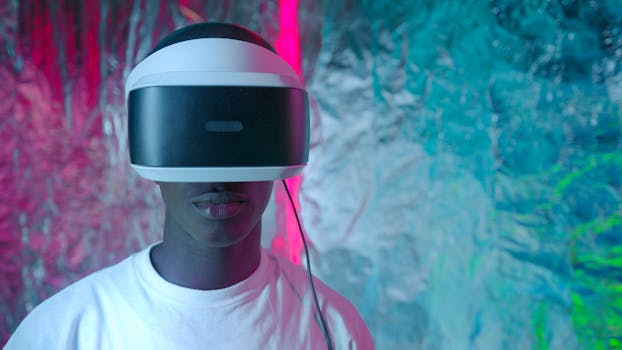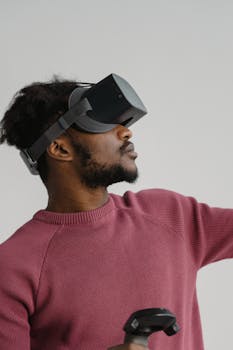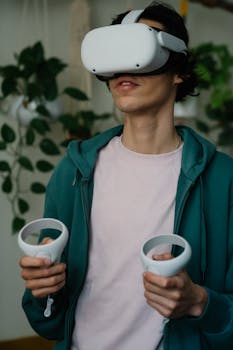Imagine putting on lightweight glasses and suddenly you’re in a game, but the game’s world blends with your living room. This describes what happens naturally through mixed reality entertainment as it integrates physical and digital worlds for a truly unique experience.
Mixed reality entertainment is redefining what we expect from immersive media, making boundaries between real and virtual play spaces vanish. This technology attracts gamers, artists, designers, and anyone seeking digital interactivity fused with the physical world in surprising new ways.
Curious about the practical uses and creative ideas mixed reality entertainment delivers? This article explores its real-world implementations, drawing you into examples, strategies, and tips to help you experience these innovative worlds first-hand.
Integrating Mixed Reality Into Everyday Experiences
Mixed reality entertainment changes the way we interact by layering digital visuals or sounds directly into daily life. When you use these technologies, the digital responds to your physical actions, enabling creative, active participation unlike any traditional form of entertainment.
Instead of just watching a screen, you move, gesture, and speak—the world around you becomes part game board, part theater, and part gallery. Let’s break down which core features set this technology apart from either virtual or augmented reality.
Blending Digital Content With The Real World
With mixed reality, objects you see on-screen feel like they truly exist on your desk, table, or floor. You can reach out, walk around them, and even interact using natural gestures. It’s as if the line dividing ‘real’ and ‘game’ hardly matters anymore.
For instance, imagine a dinosaur appearing beside your family photos or a puzzle that scatters digital pieces across your physical furniture. These interactions deepen engagement, turning everyday locations into sites of adventure or exploration.
When the digital content reacts to your exact position and movement—even light and shadows in your room—the illusion strengthens. You’re not just looking at an overlay: you’re part of an evolving, shared story or challenge.
Device Ecosystems Make Mixed Reality Accessible
Smartphones, tablets, dedicated headsets, and even lightweight glasses can offer mixed reality entertainment, each offering unique trade-offs. Some add subtle enhancements; others fully transform your environment for games, education, or art.
By supporting multiple device types, creators make sure the technology remains flexible. This approach means more people can sample or enjoy mixed reality entertainment without expensive or complicated setups. The result is broader creative participation.
Adoption increases when device ecosystems provide both affordable entry points and high-fidelity experiences. No matter where you start, there’s likely a mixed reality entertainment product or app that fits your lifestyle and tech comfort zone.
| Device | Best Use Case | Interaction Style | Getting Started Tip |
|---|---|---|---|
| Smartphone | Quick games, social experiences | Touch, gestures, AR overlays | Install mixed reality entertainment apps and grant camera access |
| Tablet | Learning, family play | Larger screen, multi-user | Explore educational mixed reality entertainment activities |
| Standalone Headset | Immersive gaming | Room-scale, hand tracking | Clear room space, adjust safety settings |
| Smart Glasses | On-the-move info | Subtle, context-aware | Pair with smartphone, try navigation features |
| PC-Connected Headset | Creative work, advanced games | Precision control, high fidelity | Check system specs and update drivers |
Designing Immersive Narratives and Gameplay That Respond to You
Mixed reality entertainment transforms your living space or office into the backdrop for interactive storytelling. You’re not following a script. Instead, each moment unfolds in real time, depending on your movement and reactions within the space.
Development studios prioritize adaptive storytelling, where music, lighting, and virtual objects change with your choices. This creates dynamic experiences that push narrative interactivity further than linear books or films ever did.
Building Real-Time Interactive Stories
Writers and designers script layers of story logic in mixed reality entertainment. If you laugh at a character or freeze during a tense puzzle, the system recognizes these cues and adjusts dialogue or events accordingly.
This isn’t about binary choices. Small gestures—like pausing, pointing, or speaking—can nudge the plot one way or another, making each play-through unique. Replay value increases as you test what else might happen the next time you interact.
For families or friends playing together, mixed reality systems even divide roles or storylines, prompting spontaneous collaboration or friendly competition, depending on your actions in the shared space.
- Test branching storylines by making unexpected choices, such as ignoring the main character for a while, and see immediate responses within the narrative.
- Coordinate gestures between friends—high-fiving in the physical world—to uncover secret paths or character reactions that only unlock through collaboration.
- Adjust environmental lighting at home to discover how mixed reality entertainment reconfigures its mood or reveals hidden story clues in shadows and corners.
- Change your speaking volume or tone during interactive dialogue scenes; many systems now adapt plot or music intensity based on how you communicate.
- Move to unexpected parts of a room or even step outside, prompting the system to expand the story’s geography dynamically in response to your exploration.
This hands-on engagement means mixed reality entertainment feels alive, keeping you invested in outcomes you can shape from moment to moment instead of passively observing.
Adaptive Audio and Visuals That Track Engagement
Mixed reality entertainment enriches spatial storytelling using microphones and cameras, sensing your attention and mood. For example, music can swell as you draw closer to a virtual mystery or fade away when you step back.
- Whisper to a virtual guide figure and hear their response physically pan around your ears, deepening immersion and encouraging exploratory listening.
- Block your ears in real life; notice that the app now visually highlights objects instead.
- Shift focus from visuals to background sounds to uncover clues missed by rushing ahead, unveiling the multilayered world built into mixed reality entertainment.
- Try shutting your eyes—some experiences react with surprise script changes or sound-based navigation tips designed for non-visual players.
- Adjust the pitch or rhythm of your footsteps and observe environmental reactions; some mixed reality entertainment engines turn movement into real-time musical accompaniments.
By rewarding playful experimentation, mixed reality entertainment encourages us to reimagine familiar spaces while tuning gameplay and narrative to individuals and groups alike.
Expanding Artistic Expression in Digital Spaces
Artists leverage mixed reality entertainment to turn architecture, parks, and gallery walls into canvases that merge painting, sculpture, and performance. These digital installations react to you and invite others to co-create or compete in real time.
Digital murals shift shape based on audience location or collective movement, making each viewing session different. Through smart devices or headsets, you can draw in the air, create virtual soundscapes, or reimagine community art with friends miles away.
Collaborative Public Art Projects
Creatives are building mixed reality entertainment apps that overlay interactive art in city spaces. You might encounter a digital sculpture superimposed on a building or animated murals triggered by motion as you pass by.
Communities are encouraged to submit their own 3D models or graffiti, creating installations anyone with a compatible device can contribute to or remix. The best ideas rise from play and shared discovery, rather than single authorship.
Locals and tourists alike photograph or record their engagement, spreading mixed reality entertainment on social media and drawing more people into the playful transformation of everyday spaces.
Immersive Live Theater and Performance
Some theaters now debut mixed reality entertainment pieces, where attendees see live actors and digital elements blend seamlessly through special glasses. Actors respond to both physical and digital cues—the outcome shifts if you move, talk, or interact differently.
For example, an audience member reaching towards an on-stage projection can cause a story twist or reveal hidden choreography. The drama is collective, shaped by subtle audience choices and feedback loops with performers.
This new genre connects people beyond the stage, making performance art participatory and evolving with each session. Performers and attendees co-author new memories every time.
Transforming Social Play and Community Events
Mixed reality entertainment builds social glue by connecting users in both shared spaces and across distances, turning games, festivals, or museum visits into collaborative challenges. Each participant brings their own device or headset, contributing unique skills to the experience.
Events no longer need everyone physically present—mixed reality entertainment blends remote players with those on site. This boost in inclusivity increases turnout, broadens age groups, and creates adaptable event formats for every occasion.
Remote Team Challenges and Group Quests
Game designers craft multi-step puzzles and races that incorporate city landmarks, public statues, or neighborhood parks. Teams solve real-world clues that trigger digital responses only once everyone works together.
One player could scan a physical mural, while another sees resulting elements appear in mixed reality. Remote participants direct on-site teammates or decode clues delivered through their devices—everyone plays, no matter the location.
Results update live, creating races to the finish, memory-sharing, laughter, and photo ops streamed instantly to online leaderboards. Mixed reality entertainment lets everyone compete without boundaries.
Community Festivals and Educational Trails
Festivals integrate mixed reality entertainment by letting attendees unlock digital performances, historical facts, or hidden games as they explore. A digital parade might appear on your device when you reach a specific spot, then reward you for collaborating with others nearby.
Interactive exhibits adapt to crowd density. If a group lingers, games might grow more complex, encouraging collaboration or competition. Trails challenge families or classmates to collect virtual badges along scenic or historic routes.
In every example, mixed reality entertainment ties learning and play directly to context—making the digital layer an indispensable and memorable part of the real-world experience.
Customizing Fitness and Movement-Based Activities
If you find exercise dull, mixed reality entertainment introduces dynamic sports and fitness activities that react to your performance. It rewards balance, agility, memory, and creativity—often transforming your living room or park into a playful gym.
Fitness developers embed real-time feedback, coaching, and adaptive soundtrack features, rewarding both form and fun. Challenges adjust on-the-fly to energy level, mood, space, or group size, keeping every player motivated and engaged from warm-up to cooldown.
Real-Time Sports Challenges Indoors and Outdoors
Apps track your running routes, then project imaginative obstacles and creatures only visible on your headset or phone. Speed up to escape a dragon or slow for stealth missions, tailoring workouts to real stamina and fantasy objectives.
At home, you can use mixed reality entertainment to turn chores into games or dance competitions. Every squat, jump, or stretch triggers points, unlocks visuals, or adds musical layers to the scene—making solo or group workouts wildly varied and replayable.
Feedback comes instantly: when you improve, digital rewards and tips evolve to push you further, preventing routines from becoming stale. Aging, injury, or disabilities can be accommodated with sensitivity settings or custom coaching strategies on any platform.
Adaptive Group Fitness and Skill Development
Schools and gyms deploy mixed reality entertainment for teamwork drills, balance training, or memory tests. Group members compete to mirror movements, solve pattern puzzles, or keep rhythm together, blending fun with measurable skill improvement.
Move in sync and the system triggers extra challenges or bonuses, providing cooperative and competitive incentives. Students or teammates compare scores immediately, keeping motivation high and showing clear progress over time.
Leaders can adapt pace, difficulty, or rules with simple voice commands. Everyone in the group sees real-time results and feedback, pushing for new personal or collective bests in a safe, supportive environment.
Pioneering Education and Scientific Discovery
Mixed reality entertainment turns classrooms and research spaces into living laboratories. Learners experiment with physics, chemistry, or history by interacting with animated simulations that float mid-air or transform schoolyards into adventure grounds for discovery.
Teachers and scientists use mixed reality entertainment for safe, repeatable, and vivid demonstrations. It lets students touch, reshape, or test real-time hypotheses, building lasting understanding beyond passive lectures or static screens.
Hands-On Learning With Interactive Labs
Launch a virtual volcano or assemble a digital skeleton by gesturing in the air—mixed reality entertainment invites trial and error. Each lesson adapts instantly, offering hints, prompting teamwork, and revealing micro-details invisible to the naked eye.
Students can compete to solve molecular puzzles, adjust parameters in evolutionary simulations, or collaborate on experiments remotely. These tactile experiences help cement theory into practical wisdom, making abstract concepts tangible.
Mixed reality entertainment accelerates learning by appealing to curiosity, mistake-making, and playful debate. Badges or scores incentivize creative problem-solving, with reflection prompts before moving to the next lesson segment.
Fieldwork, Exploration, and Citizen Science
Researchers can deploy mixed reality entertainment to overlay field notes, animal tracks, or plant database information directly onto landscapes or lab benches. Collectors snap photos, share findings, and annotate specimen virtually without tampering with real ecosystems.
Citizen scientists can participate in group challenges, climb leaderboards, and share findings for collective study. By transforming discovery into an ongoing game, mixed reality entertainment attracts new generations of explorers and collaborators.
Whether you’re monitoring weather, stars, or urban wildlife, mixed reality entertainment lowers the barriers to entry, drawing in curious participants and making meaningful contributions to science accessible to anyone with a compatible device.
| Activity | Platform | Interaction | Instructional Takeaway |
|---|---|---|---|
| Volcano Simulation | Headset, tablet | Gesture-based | Adjust eruption settings and observe results for safe, repeatable labs |
| Virtual Anatomy Lab | Tablet, phone | Touch and AR overlays | Identify organs by rotating and tapping for instant fact recall |
| Environmental Data Logging | Smartphone, glasses | Photo and annotation | Contribute crowd-sourced samples from anywhere on field trips |
| Historical Reenactments | Headset, projection | Move and role-play | Interact with historic figures and artifacts in real-world schoolyards |
| Chemistry Puzzle Games | Tablet, PC | Drag and match | Practice safe reactions and test predictions with real-time feedback |
Maintaining Privacy and Accessibility for All
For mixed reality entertainment to reach everyone, designers consider privacy, physical accessibility, and diverse use environments. Each new app or experience prompts careful thought on permissions, safety, and user control—protecting both data and wellbeing.
Successful developers build transparency into device permissions, clear on-screen warnings for real obstacles, and robust parental controls. Experiences now scale across body types, mobility levels, and visual or auditory abilities, keeping everyone included.
Setting Physical Boundaries for Safe Play
Mixed reality entertainment systems prompt users to map play areas, identifying stairs, fragile objects, pets, or children before starting an experience. Visual or audio cues alert you if you stray too close to hazards.
Safe play scripts include reminders to pause, hydrate, or remove headsets after set intervals. Keeping the play zone clear and inviting others to signal if you’re at risk preserves safety in both solo and group sessions.
Designers test experiences with a variety of body types and movement ranges, ensuring everyone sees clear, comfortable alerts adapted to specific environments and challenges.
Respecting Data and Personal Space
Apps only access cameras, microphones, or GPS if you grant explicit permissions. Most modern mixed reality entertainment systems let you review data use policies and restrict access any time through intuitive controls.
For social experiences, anonymous or pseudonymous play reduces risk from unwanted disclosures. Parental controls and moderation tools help children and families tailor experiences and report inappropriate interactions quickly.
Guides, troubleshooting, and reporting systems are accessible in multiple formats, from text to voice, ensuring mixed reality entertainment grows responsibly and inclusively as it meets real-world needs.
Future Horizons of Mixed Reality Entertainment
Mixed reality entertainment technologies will continue merging creativity and science, making impossible experiences routine in home, school, and public spaces. Constant improvements in battery life, displays, haptics, and software will further blur distinctions between digital and physical creativity.
Communities and creators worldwide add new voices each day—artists, teachers, programmers, and fans working together to define what interactive entertainment means for all. Custom content, crowd-sourced challenges, and open tools unlock invention everywhere.
As mixed reality entertainment matures, expect rules and norms to evolve—balancing fun with privacy, inclusion, and accessibility. The result is a culture that values both shared wonder and individual creativity, wherever and however you choose to play.



